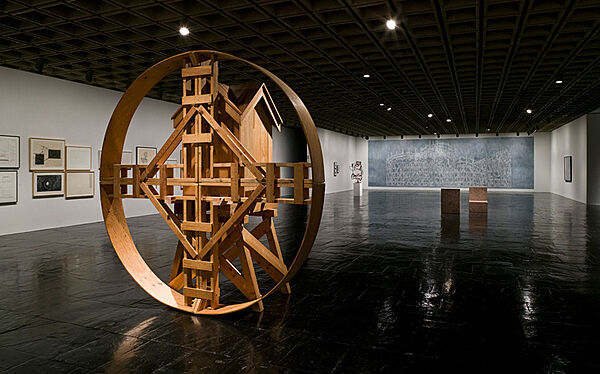Sites
Feb 19–May 3, 2009
Sites
The works on view in this installation demonstrate various ways artists have expanded and complicated the notion of site or place in art. Instead of attempting to realistically depict physical places—interiors, landscapes, or city views—some artists in the postwar period pushed the boundaries of sculpture and adopted time-based media to forge new connections among the viewer, the object, and the surrounding space. This resulted in works that not only represent sites but also serve as locations for a different kind of physical experience or imaginative contemplation.
Throughout his career, the artist David Smith took photographs of his sculptures in the places that inspired them. For example, he shot his steel sculpture entitled Hudson River Landscape (1951) outside his upstate New York studio in an effort to draw attention to the complex formal relationship between the sculpture and its natural surroundings. This emphasis on the work and the site of its creation ultimately served as a precedent for artists of the late 1960s and early 1970s, including Robert Morris, Barry Le Va, and Michael Heizer. These artists conceived their sculptural work with a particular place in mind and used drawing to delineate their artistic actions before execution. More than just traditional preparatory sketches, these drawings document temporary works or represent site-specific projects that were potentially unrealizable. A group of prints by Robert Morris propose a number of dramatic interventions into the landscape, ranging from a burning lake to a hovering cloud of dust. Other artists such as Agnes Denes, with her map projection drawings, transform familiar images of the natural environment to suggest utopian relationships between us and our surroundings. Alice Aycok’s monumental sculpture Untitled (Shanty) (1978) draws upon vernacular architecture and everyday materials to create a work that is both familiar and strange.
More recently, artists have moved fluidly between the site specific and the visionary—often using drawing and video to combine these two positions. Gary Simmons’s wall drawing Ghoster (1997) registers the trace of the artist’s presence through a spectral roller coaster rendered in chalk, while also presenting a site that seems to exist more fully as a memory. Similarly, Doug Aitken’s enveloping multi-screen video installation Electric Earth (1999) offers an experience of time and space that hovers between the real and the imaginary. As technology continues to evolve, artists will no doubt find new ways to examine how the idea of site fits into our perception of the world in ways both abstract and concrete.
This exhibition is organized by Carter E. Foster, curator of drawings, and Gary Carrion-Murayari, senior curatorial assistant.

